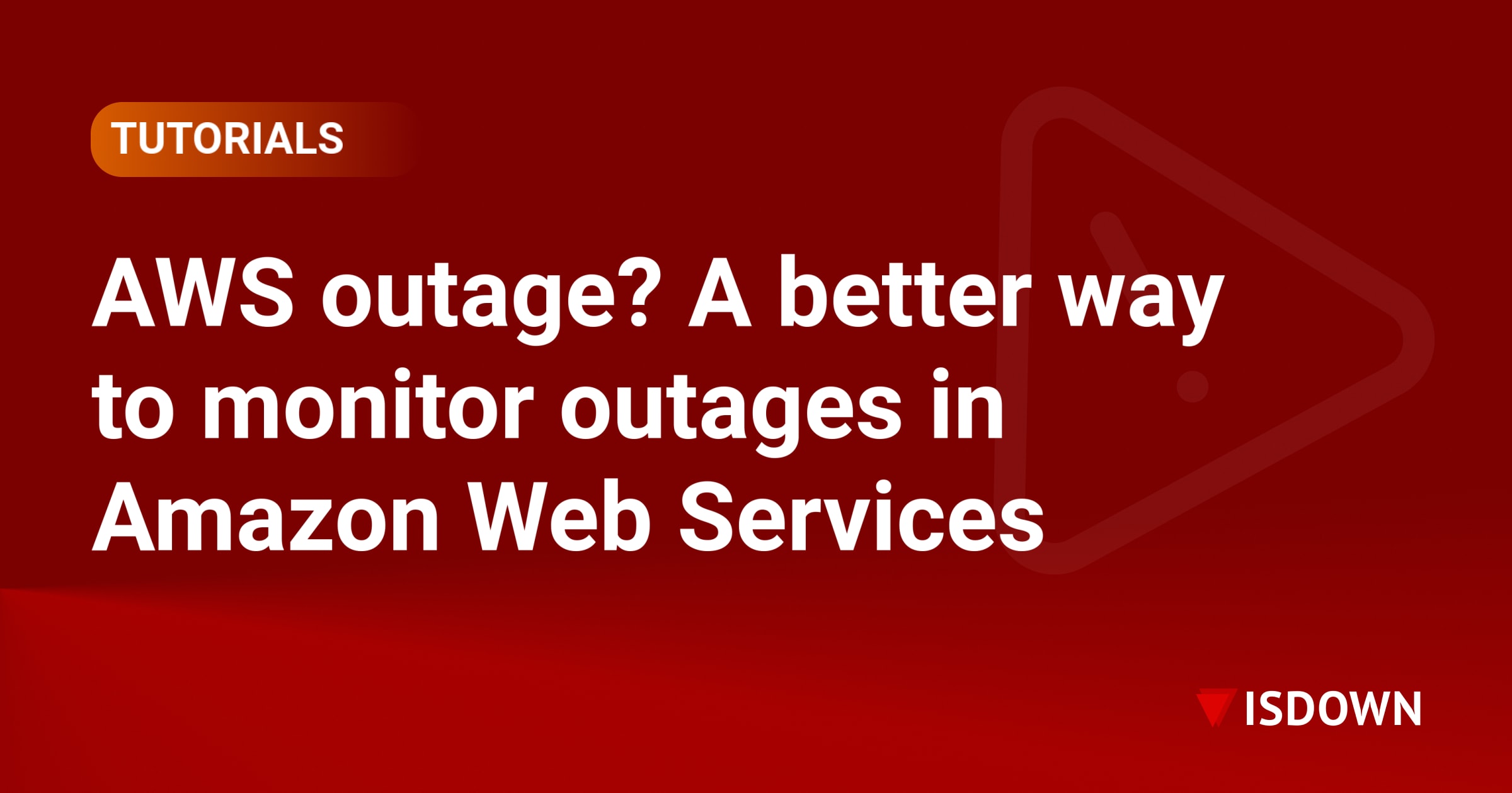Best Downdetector Alternatives for Outage Monitoring in 2025

To keep operations running, businesses and individuals increasingly rely on online services. When outages occur, having the right tools to detect and respond quickly is essential. Outage monitoring platforms provide real-time insights into service disruptions, helping minimize downtime and maintain productivity.
While Downdetector is a widely recognized platform, its focus on consumer-level features may not fully meet business needs. Organizations relying on multiple third-party services require tools with advanced capabilities like deeper insights, customizable notifications, and seamless integrations.
What Does Downdetector Do and How Does It Work?

Downdetector is a well-known platform for real-time outage monitoring of internet services, websites, mobile applications, and service providers. By analyzing crowdsourced user reports, it provides a snapshot of service health, helping users and organizations identify ongoing issues quickly.
SRE teams, along with system administrators and customer support, rely on tools like Downdetector to monitor disruptions that may impact their operations. While it offers an API for integrating notifications into business systems, its features are largely tailored for general users.
It is free for basic use, but businesses requiring advanced capabilities—like customizable alerts, seamless integrations, or detailed reliability insights—may benefit from exploring other platforms designed to meet their specific needs.
Reasons to Explore Downdetector Alternatives
For businesses relying on multiple third-party services, detailed and reliable outage information is vital for efficiency and minimizing downtime. While Downdetector is widely recognized, it primarily serves consumers, leaving gaps for businesses with more complex needs.
Limitations of Downdetector
Consumer-Focused Approach
Downdetector relies heavily on crowdsourced reports, making it effective for identifying general outages. However, this approach may lack the precision and granularity businesses require. Companies often need detailed information on individual service components or regional impacts, which Downdetector does not provide.
Unofficial and Incomplete Data
Since the platform depends on user-submitted reports, there is a risk of incomplete or delayed updates. For organizations needing real-time accuracy, these limitations can hinder incident response and vendor accountability.
Limited Business-Specific Features
While Downdetector does offer a paid Enterprise plan with features like location-based outage reports and comparative views, these are not its primary focus. Businesses may find its offerings less robust compared to platforms specifically designed for enterprise use.
Restricted Notifications
Non-subscribers are limited to Twitter notifications, and businesses seeking advanced, customizable alerts across tools like Slack or PagerDuty may find this insufficient.
Cluttered User Experience
Advertisements on the platform can detract from usability, and its interface prioritizes user-reported submissions over delivering instant, actionable insights—something business users often require.
Why Alternatives Matter for Businesses
Businesses with complex service dependencies often need more than what Downdetector can provide. Tools tailored to business users can address these gaps by offering features such as:
Aggregated and Verified Data: Beyond crowdsourced reports, combine official status updates with real-time insights to ensure data accuracy.
Customizable Alerts: Advanced tools allow businesses to define how and where they receive notifications, reducing alert fatigue and improving response times.
Integration with Existing Workflows: Platforms that integrate seamlessly with tools like Slack, Microsoft Teams, and PagerDuty make it easier for teams to manage outages within their existing systems.
Comprehensive Global Monitoring: For global enterprises, extensive coverage across regions ensures no outage goes unnoticed.
Best Downdetector Alternatives in 2025
1. IsDown

IsDown is a modern third-party outage monitoring platform designed to simplify service monitoring for businesses. By aggregating data from over 3,550 official status pages and combining it with crowdsourced reports, IsDown ensures that users are promptly informed about outages.
Its user-friendly dashboard, customizable alerts, and seamless integrations make it an ideal solution for businesses relying on multiple cloud services.
Key Features
Collected data from official status pages and crowdsourced reports.
Customizable notifications delivered to Slack, Microsoft Teams, PagerDuty, Datadog, and more.
Real-time updates and historical outage data for better vendor performance insights.
Public and private status pages with custom branding and password protection.
Uptime, SSL, and keyword monitoring for user services.
Multi-location monitoring and maintenance window tracking.
Advantages
Combines crowdsourced insights with official status updates for accurate monitoring.
Customizable alerts to avoid notification fatigue.
Easy integration with existing workflows and tools.
Real-time updates ensure businesses can respond quickly to outages.
A user-friendly, visually appealing dashboard designed for teams of all sizes.
14-day free trial with no credit card or coding required.
Disadvantages
May require some onboarding for teams unfamiliar with status aggregation tools.
Businesses relying exclusively on free tools might find it less accessible compared to consumer-oriented platforms.
Pricing

2. StatusSight

StatusSight monitors 3,000+ popular services and APIs for outages and incidents. It allows users to create custom dashboards and set up email alerts to stay ahead of service disruptions across infrastructure, APIs, DevOps, IT, marketing, sales, and operations.
By consolidating status updates from thousands of status pages into a single dashboard, StatusSight helps businesses track real-time service availability without manually subscribing to multiple vendor pages.
Key Features
Status Aggregation: Consolidates status updates for 3,000 SaaS providers, apps, and websites in one dashboard.
Centralized Dashboard: Displays the statuses of critical services for quick, at-a-glance updates.
Real-time Outage Alerts: Notifies users of incidents as they happen.
Custom Dashboard Creation: Users can configure their own dashboards based on the services they rely on.
Incident Tracking and Updates: Tracks ongoing incidents and provides timely notifications.
Advantages
Monitors thousands of status pages in real-time, continuously processing and summarizing data.
Saves time by eliminating the need to subscribe to multiple status pages individually.
Reduces notification noise by providing a single, centralized view of all monitored services.
Ensures businesses never miss a critical outage alert with real-time email notifications.
Disadvantages
Service Coverage Constraints: Covers fewer services compared to some alternatives.
Lacks Custom Notifications: No advanced filtering or tailoring of alerts based on specific incidents.
No Status Page Capabilities: Does not offer public or private status page creation.
Limited Integrations: Does not integrate with Slack, Microsoft Teams, PagerDuty, or other notification platforms.
Pricing
- StatusSight provides a free version, but you'll need to contact them directly for extra dashboards. Pricing information is not disclosed.
3. EagleStatus

EagleStatus is a straightforward status monitoring tool designed to help businesses track the performance of the services they rely on. With real-time updates and support for over 1,700 services—including AWS, Google Cloud, GitHub, and Zoom—EagleStatus provides an aggregated dashboard for centralized monitoring.
The platform focuses on simplicity and affordability, making it ideal for small to medium-sized teams. However, businesses with more complex needs might explore other status monitoring solutions that offer advanced analytics, scalability, or additional customization options.
Key Features
Aggregated Status Pages: Centralized monitoring of SaaS and cloud services for quick identification of issues.
Customizable Notifications: Focused alerts for specific services, components, and regions via Slack, Discord, MS Teams, or webhooks.
Real-Time Updates: Notifications for the entire lifecycle of an outage, from start to resolution.
Shareable Dashboards: Easily share real-time service updates with your team through links or office displays.
Quick Setup: Get started within minutes with a free plan that includes 5 monitors.
Advantages
Affordable pricing plans, starting with a free option.
Simple, user-friendly interface suitable for small and medium-sized teams.
Notifications tailored to reduce noise and focus on critical updates.
Easy dashboard sharing for team collaboration or display.
Real-time lifecycle updates ensure full visibility into outages.
Disadvantages
Limited to 90 monitors in the premium plan, which may not be enough for larger enterprises.
Lacks advanced features like historical data analysis or predictive analytics for long-term planning.
Focuses more on simplicity, which might not meet the needs of complex or large-scale operations.
Pricing

4. Down for Everyone or Just Me

Down for Everyone or Just Me is a simple, consumer-oriented platform designed to check website outages and service issues in real-time. It uses crowdsourced reports to provide live status updates and features a minimalist design that is user-friendly.
However, its focus on consumer services limits its utility for businesses seeking detailed monitoring of B2B applications or comprehensive service tracking.
Key Features
Crowdsourced Outage Reports: Real-time status updates based on user submissions.
Minimalist Design: A clean, user-focused interface for quick outage verification.
Website Outage Monitoring: Allows users to check if a website is down for everyone or just their network.
Advantages
Free to Use: A cost-effective option for checking website statuses.
Simple and Intuitive: Minimalistic layout allows for quick and easy navigation.
Disadvantages
Limited to Consumer Services: Does not cater to businesses needing to monitor B2B tools or SaaS applications.
No Comprehensive Dashboard: Lacks a summary view of popular services' current statuses.
No Historical Data or Maintenance Information: Users cannot analyze past outages or plan around scheduled downtimes.
Slower Performance: Outage verification can take longer compared to other alternatives.
Pricing
- Free Service
5. StatusTicker

StatusTicker is a proactive status monitoring tool designed for businesses that prioritize clear communication during service interruptions. It provides extensive service monitoring with customizable notifications and branded status pages for both public and private use.
With integration into popular tools like Slack, MS Teams, and PagerDuty, StatusTicker ensures seamless incident communication and team-wide visibility.
Key Features
Comprehensive Service Monitoring: Tracks over 905 services and thousands of individual components, with regular updates to stay current.
Customizable Alerts: Receive tailored updates for specific services, components, or regions across multiple channels like email, SMS, Slack, Telegram, and PagerDuty.
Branded Status Pages: Create public or private status pages ("tickers") with white-labeling options for full customization.
Real-Time Updates: Stay informed about outages, maintenance, and warnings as they happen, with the ability to display live statuses on office TVs or wallboards.
Seamless Integrations: Connect to tools like Slack, MS Teams, PagerDuty, and webhooks for advanced incident management workflows.
Advantages
Affordable plans with unlimited monitors and flexible pricing.
Granular monitoring and alerting options to minimize notification overload.
Fully customizable, branded status pages for effective communication with customers and teams.
Wide integration support for existing workflows and tools.
Real-time updates provide transparency and operational clarity.
Disadvantages
Focused on communication and status page customization, so it may lack advanced analytics or historical data tracking.
Best suited for businesses prioritizing customer communication rather than detailed performance monitoring.
Limited service coverage compared to some competitors, with 905+ services monitored.
Pricing

6. Outage.Report

Outage.Report is a real-time outage notification platform similar to Downdetector, relying on crowdsourced data to track service disruptions.
The platform provides a global perspective with service-specific data for nine countries, multilingual support, and features such as outage maps, Twitter feeds, and a comment section. It offers historical data and free access to users, making it a handy tool for basic monitoring needs.
Key Features
Crowdsourced Outage Reports: Consolidates data from user submissions for real-time updates.
Recent Outage History: Displays reports from the last 48 hours on the homepage.
Country-Specific Service Lists: Tracks outages across nine countries, catering to a global audience.
Historical Data: Access detailed outage history going back several months.
Outage Maps: Visualizes disruptions geographically for each service.
Twitter Feed: Aggregates posts related to service issues from Twitter.
Comments Section: Users can report and discuss issues in real time.
Multilingual Support: Available in nine different languages.
Advantages
Free to use for all users.
Quick access to recent outage reports directly on the homepage.
Historical data for several months helps analyze recurring issues.
Regional focus with country-specific service tracking.
Multilingual interface caters to a broader audience.
Disadvantages
Cluttered Interface: Service status pages can feel overwhelming and hard to navigate.
Consumer-Focused: Limited coverage of critical cloud services and SaaS platforms that businesses depend on.
US Service Limitation: Fewer U.S.-based services are monitored compared to other platforms.
Reliability Concerns: Outage data depends solely on user reports, lacking direct confirmation from service providers.
Pricing
- Free Service
7. Is The Service Down

Is The Service Down is a platform that provides real-time outage notifications primarily for consumer services. Similar to Downdetector, it aggregates user-submitted outage reports to display the status of services in real-time.
The platform categorizes outages, provides a map view of affected areas, and includes features like a live Twitter feed and comment sections, making it an interactive tool for users.
Key Features
Crowdsourced Outage Data: Aggregates user-reported outages for real-time updates.
Categorized Reports: Breaks down service issues into specific categories for clarity.
24-Hour History: Offers a timeline of outages from the past 24 hours.
Map View: Displays the geographic locations of reported outages for regional context.
Live Twitter Feed: Aggregates recent tweets from users and service providers.
Commenting Feature: Allows users to share insights and discuss service issues.
Advantages
Free to use for all users.
Detailed breakdown of service issues by category.
Interactive map for visualizing regional disruptions.
Historical data on outages for the last 24 hours.
Live updates through Twitter feeds and user comments.
Disadvantages
Limited Coverage: Focused on consumer services; lacks many critical cloud and SaaS platforms needed by businesses.
Geographical Limitation: Covers only a limited number of U.S.-based services.
Reliability Concerns: Data is crowdsourced and lacks official confirmation from service providers.
Ads: Heavy use of ads detracts from the professional feel of the platform.
Consumer Focused: Not ideal for businesses needing comprehensive monitoring solutions.
Pricing
- Free Service
Factors to Consider When Choosing a Monitoring Tool
Selecting the right monitoring tool is crucial to ensure your business can quickly identify and respond to service disruptions. Here are key factors to consider when evaluating your options:
Scope of Service Monitoring
Look for a tool that covers the services and platforms your business relies on. Comprehensive monitoring of cloud providers, SaaS tools, and critical infrastructure ensures no outages go unnoticed. For example, IsDown monitors over 3,550 services, combining official updates with crowdsourced reports for broader coverage.
Real-Time Alerts and Notifications
Timely notifications are essential for quick responses to incidents. Choose a tool that delivers customizable alerts across your preferred channels, such as Slack, Microsoft Teams, or email. IsDown excels in this area with tailored notifications to reduce alert fatigue.
Ease of Integration
The tool should integrate seamlessly with your existing workflows and tools, such as incident management platforms or communication apps. IsDown offers integrations with Slack, PagerDuty, Datadog, and more, ensuring smooth implementation without disrupting your processes.
Customizable Dashboards and Status Pages
A user-friendly, centralized dashboard is vital for tracking service statuses efficiently. Additionally, the ability to create public and private status pages helps communicate service updates to customers and internal teams. IsDown provides branded, shareable status pages for transparency and collaboration.
Historical Data and Analytics
Analyzing past outages helps identify patterns and assess vendor performance. Tools that offer historical data, like IsDown, enable businesses to make informed decisions about their service dependencies.
Affordability and Scalability
Consider whether the tool's pricing aligns with your budget and if it can scale as your business grows. IsDown offers a free trial with no credit card required, allowing you to evaluate its features risk-free.
Stay Ahead of Service Outages with IsDown
Monitoring service outages is essential for businesses that rely on multiple third-party services. While Downdetector is a popular choice, it may fall short for businesses with more advanced monitoring needs. Thankfully, there are several alternatives offering tailored features to address these challenges.
Among them, IsDown stands out as a robust, business-focused solution. With real-time alerts, aggregated data from thousands of services, seamless integrations, and customizable dashboards, IsDown helps businesses stay ahead of outages and reduce downtime. Its combination of official updates and crowdsourced insights ensures accurate and timely information for faster response times.
Whether you're a SaaS provider, managed service provider, or part of a DevOps team, choosing the right tool can transform how you handle service disruptions. Try IsDown's 14-day free trial to see how it can streamline your service monitoring.
 Nuno Tomas
Founder of IsDown
Nuno Tomas
Founder of IsDown





